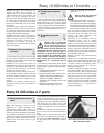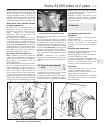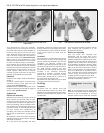
7 Remove the drain plug, and allow the
coolant to drain into the container.
8 If the coolant has been drained for a reason
other than renewal, then provided it is clean
and less than two years old, it can be re-used,
though this is not recommended.
9 Refit the radiator and cylinder block drain
plugs on completion of draining.
Cooling system flushing
10 If coolant renewal has been neglected, or
if the antifreeze mixture has become diluted,
then in time, the cooling system may gradually
lose efficiency, as the coolant passages
become restricted due to rust, scale deposits,
and other sediment. The cooling system
efficiency can be restored by flushing the
system clean.
11 The radiator should be flushed
independently of the engine, to avoid
unnecessary contamination.
Radiator flushing
12 To flush the radiator, first tighten the
radiator drain plug.
13 Disconnect the top and bottom hoses and
any other relevant hoses from the radiator,
with reference to Chapter 3.
14 Insert a garden hose into the radiator top
inlet. Direct a flow of clean water through the
radiator, and continue flushing until clean
water emerges from the radiator bottom
outlet.
15 If after a reasonable period, the water still
does not run clear, the radiator can be flushed
with a good proprietary cleaning agent. It is
important that their manufacturer’s
instructions are followed carefully. If the
contamination is particularly bad, insert the
hose in the radiator bottom outlet, and
reverse-flush the radiator.
Engine flushing
16 To flush the engine, first refit the cylinder
block drain plug, and tighten the cooling
system bleed screws.
17 Remove the thermostat as described in
Chapter 3, then temporarily refit the
thermostat cover.
18 With the top and bottom hoses
disconnected from the radiator, insert a
garden hose into the radiator top hose. Direct
a clean flow of water through the engine, and
continue flushing until clean water emerges
from the radiator bottom hose.
19 On completion of flushing, refit the
thermostat and reconnect the hoses with
reference to Chapter 3.
Cooling system filling
20 Before attempting to fill the cooling
system, make sure that all hoses and clips are
in good condition, and that the clips are tight.
Note that an antifreeze mixture must be used
all year round, to prevent corrosion of the
engine components (see following sub-
Section). Also check that the radiator and
cylinder block drain plugs are in place and
tight.
21 Remove the expansion tank filler cap.
22 Open all the cooling system bleed screws
(see paragraph 4).
23 Some of the cooling system hoses are
positioned at a higher level than the top of the
radiator expansion tank. It is therefore
necessary to use a “header tank” when
refilling the cooling system, to reduce the
possibility of air being trapped in the system.
Although Peugeot dealers use a special
header tank, the same effect can be achieved
by using a suitable bottle, with a seal between
the bottle and the expansion tank. On some
engines, the expansion bottle/tank can be
simply released from its normal location,
raised as high as possible and tied to the
bonnet to form the “header” tank.
24 Fit the “header tank” to the expansion
tank and slowly fill the system. Where the
radiator incorporates a filler cap, fill the
radiator first until it is overflowing, and refit the
filler cap (see illustration). Now, on all
models, slowly fill the “header” tank. Coolant
will emerge from each of the bleed screws in
turn, starting with the lowest screw. As soon
as coolant free from air bubbles emerges from
the lowest screw, tighten that screw, and
watch the next bleed screw in the system.
Repeat the procedure until the coolant is
emerging from the highest bleed screw in the
cooling system and all bleed screws are
securely tightened.
25 If a separate bottle is being used as the
“header tank”, ensure it is full (at least 0.5
litres of coolant). If the vehicle expansion
bottle/tank is being used as the “header” tank,
ensure it is filled to the “MAX” markings (see
illustration). Start the engine, and run it at a
fast idle speed (do not exceed 2000 rpm) until
the cooling fan cuts in, and then cuts out.
During this time, squeeze the top and bottom
radiator hoses to allow any trapped air to rise.
Every 2 years 1•21
1
33.5a Cooling system bleed screws may
be located in the heater hose . . .
33.5b . . . in the inlet manifold coolant
hose . . .
33.5c . . . or on the thermostat housing
(arrowed)
33.24 Fill the radiator through the filler (arrowed) on the left-hand side


















